Delicious Korean Food Side Dishes to Pair with Every Meal

Ever been amazed by the taste of a meal? It happened to me with Korean side dishes. Picture this: a table full of colorful, tasty dishes. These Korean food side dishes do more than just sit there. They are key to Korean cuisine, bringing balance and a flavor burst to your meal.
As a kid, mealtime was a fun adventure due to these side dishes. Kimchi’s spice or stir-fried veggies’ savoriness has a special effect. They introduce us to a culture that cherishes harmony and variety at the dinner table. It’s fascinating how these traditional Korean side dishes make dinner special. And they are easy to make at your house.
Are you ready to explore the tasty and healthy world of Korean side dishes? Join me as we find out how they can improve your meals. And show you a bit of Korean culture right at your table!
Key Takeaways
- Korean food side dishes are crucial for Korean cuisine, adding balance and variety.
- They boost nutrition, flavor, and texture in every dish.
- Favorites like kimchi and banchan offer a deep cultural experience.
- It’s simple to make these dishes at home with basic ingredients.
- Adding Korean side dishes can change any meal into a colorful, tasty celebration.
Introduction to Korean Food Side Dishes
Hey there! Ready to explore Korean side dishes, or banchan? They’re central to Korean meals. Whether you’re a newbie or a pro, knowing these dishes is key for cooks. So, let’s dive in!
Korean side dishes aren’t just extras; they’re stars on their own. Think fermented kimchi and seasoned treats. Picture a table with colorful plates, each offering different flavors and textures!
Talking about Korean side dishes, we can’t skip their cultural role. They come with rice and the main dish, making meals balanced and nutritious. They let you enjoy many flavors at once. Isn’t that thrilling?
What’s unique about these dishes? They blend sweet, salty, spicy, and sour tastes. From strongly fermented kimchi to gentle namul, they show Korean cuisine’s range. They’re healthy, thanks to fresh ingredients.
Inspired to try making banchan? Don’t worry, it’s not too hard. With a bit of help, you’ll impress everyone with tasty, authentic dishes. So, put on your apron, and let’s dive into Korean side dishes!
| Type of Dish | Flavor Profile | Popular Examples |
|---|---|---|
| Fermented | Spicy, Sour | Kimchi, Jangajji |
| Pickled | Sour, Sweet | Oi Muchim, Ggakdugi |
| Seasoned | Salty, Nutty | Namul, Jorim |
Popular Types of Korean Side Dishes
Let’s explore the tasty world of Korean side dishes! They’re not just extras but key to the Korean meal, adding lots of flavors and textures. From famous kimchi to various banchan, there’s a lot to discover! Ready to begin?
Kimchi: The Iconic Korean Ferment
Kimchi shines as the star of Korean food. It’s a spicy fermented mix of napa cabbage and radishes, with chili powder, garlic, ginger, and fish sauce. The fermenting makes kimchi tangy and healthy. There are many kinds to try, each with their own twist. Kimchi is great with rice or in stews like kimchi jjigae. It’s a Korean table essential!
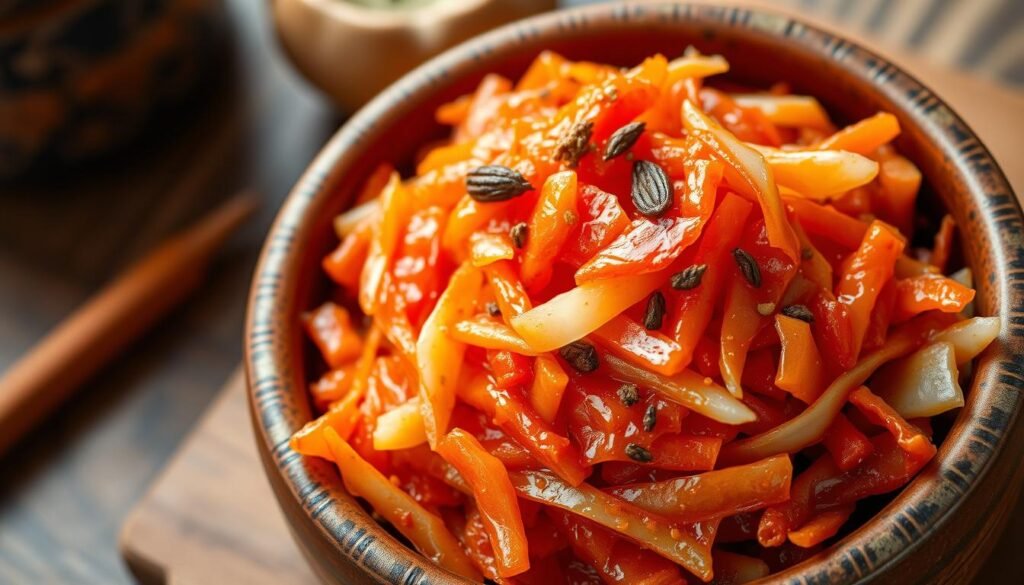
Pickled Vegetables: A Crunchy Delight
Now, onto Korean pickled vegetables. They offer a crispy contrast to Korea’s rich dishes. You’ll see pickled radishes, cucumbers, and turnips often. They’re brined in vinegar, sugar, and sometimes Korean chili powder for extra zest. These pickles are flavorful and help digestion, making them popular.
Banchan: A Variety of Small Plates
*Banchan* means small side dishes that come with rice. Korean food’s variety really shows in these dishes. From savory pancakes (jeon) to stir-fried veggies (namul), each choice adds to the meal. Every home or restaurant may serve different banchan, making dining exciting. These dishes balance the meal’s flavors and textures.
| Type | Ingredients | Flavor Profile |
|---|---|---|
| Kimchi | Napa cabbage, radish, garlic, ginger, fish sauce | Spicy, tangy, umami |
| Korean Pickled Vegetables | Cucumber, radish, turnip, vinegar, sugar | Crunchy, slightly sweet, tangy |
| Banchan | Varied (e.g., spinach, jeon, namul) | Diverse flavors from savory to spicy |
These favorite Korean side dishes make meals more fun and interesting. Whether you’re new to Korean food or already love it, there’s always something exciting to try!
How to Make Kimchi at Home
Making kimchi at home is easier than you might think! You just need some simple ingredients and patience. You’ll soon be enjoying your own delicious kimchi. Let’s start the fun process!
Ingredients You’ll Need
First up, gather your ingredients. Here’s your classic DIY kimchi list:
– Napa cabbage
– Korean radish
– Carrots
– Green onions
– Garlic cloves
– Ginger
– Gochugaru (Korean red chili flakes)
– Fish sauce
– Soy sauce
– Sugar
– Salt
Step-by-Step Preparation
With everything ready, let’s follow our Korean kimchi recipes:
1. Slice and Salt Cabbage: Cut the Napa cabbage into quarters. Sprinkle salt between the leaves. Wait a couple of hours until it softens.
2. Rinse and Drain: Wash the cabbage with cold water to remove salt and drain well.
3. Prepare the Veggies: Cut the radish and carrots into thin strips. Chop the green onions.
4. Make the Paste: Puree garlic, ginger, gochugaru, fish sauce, soy sauce, and some sugar into a thick paste.
5. Mix Everything: Mix the paste and veggies. Make sure each cabbage leaf is well coated.
6. Pack into Jars: Fill jar(s) with the coated cabbage, leaving no air inside.
7. Ferment: Leave it at room temp for 1-5 days. Check the taste daily until it’s just right.
Common Mistakes to Avoid
Avoid simple errors for the best kimchi:
– Over-salting the cabbage: Rinse well to keep your kimchi from being too salty.
– Skipping the fermentation check: Taste it daily so it won’t get too sour.
– Not using fresh ingredients: The freshest veggies make the best kimchi.

That’s your guide to making kimchi at home! Are you ready to add a bit of Korea to your kitchen?
Essential Korean Ingredients for Side Dishes
Creating yummy Korean side dishes needs a few key ingredients. Let me show you some important ones. In my kitchen, Gochujang, Korean sesame oil, and Doenjang are always there. They add special tastes and depths. Ready to dive in? Let’s go!
Gochujang: The Sweet and Spicy Paste
First, let’s talk about Gochujang. It’s a fermented red chili paste key to Korean food. It mixes sweet and spicy perfectly, adding zest to many dishes. Whether it’s for a tangy bibimbap or BBQ marinade, Gochujang is a star. It makes simple ingredients taste amazing!
Sesame Oil: A Nutty Flavor Enhancer
Next, there’s Korean sesame oil. This oil has a nutty scent and upgrades many Korean dishes. Use it on veggies or in sauces. Or put it on banchan to make it special. Once you try it, you’ll use it all the time!
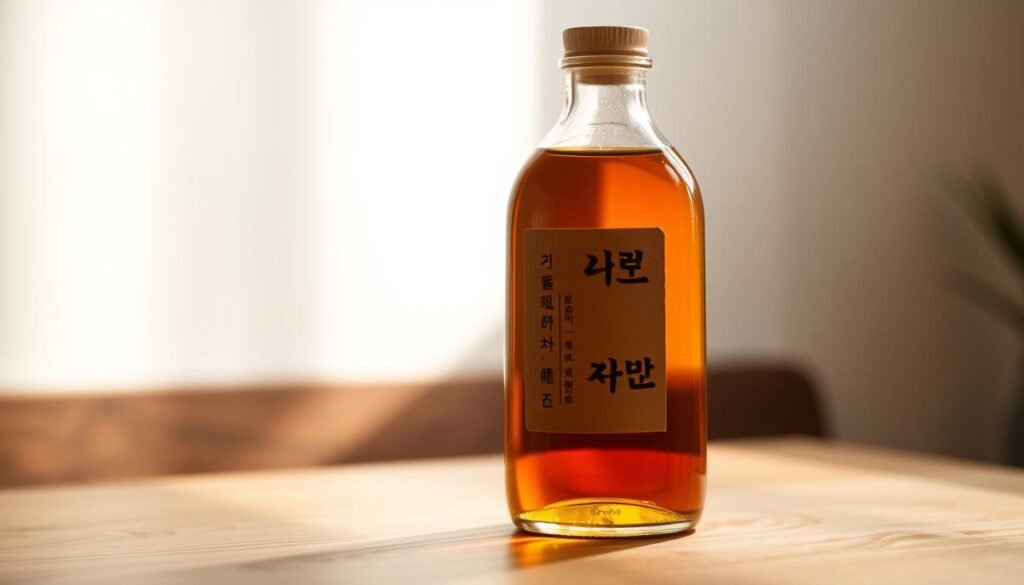
Doenjang: The Rich Fermented Soybean Paste
Last is Doenjang, a thick soybean paste. It’s savory with a deep taste. In Korean cooking, it’s used a lot in stews, soups, and marinades. Its strong flavor comes from fermenting. It is perfect for making Korean dishes stand out!
So, those are the three key ingredients for Korean side dishes. With Gochujang, Korean sesame oil, and Doenjang, you can make amazing dishes. Your family and friends will be impressed!
Cooking Techniques for Korean Side Dishes
Mastering key Korean cooking techniques is crucial for delicious side dishes. These methods bring out unique flavors and textures. Let’s look at fermentation and stir-frying, the two main techniques.
Fermentation: The Heart of Flavor
Fermentation is an art. It requires patience as vegetables soak in seasoned brine for weeks. This process makes flavors deep and adds good probiotics for your gut. Kimchi is a well-known example, but radishes and cucumbers can also be fermented beautifully. Have you tried making your own fermented treats? It’s not as hard as it sounds and very rewarding!
Stir-Frying: Quick and Delicious
Stir-fry recipes in Korean cooking are fast and tasty. Ingredients cook quickly over high heat with a bit of oil. You get crisp veggies and juicy meats full of flavor! Gochujang noodles and various vegetable dishes are Korean favorites, thanks to stir-frying.
Fermenting and stir-frying are key to authentic, delicious Korean meals. You can use these techniques in your weekly cooking easily!
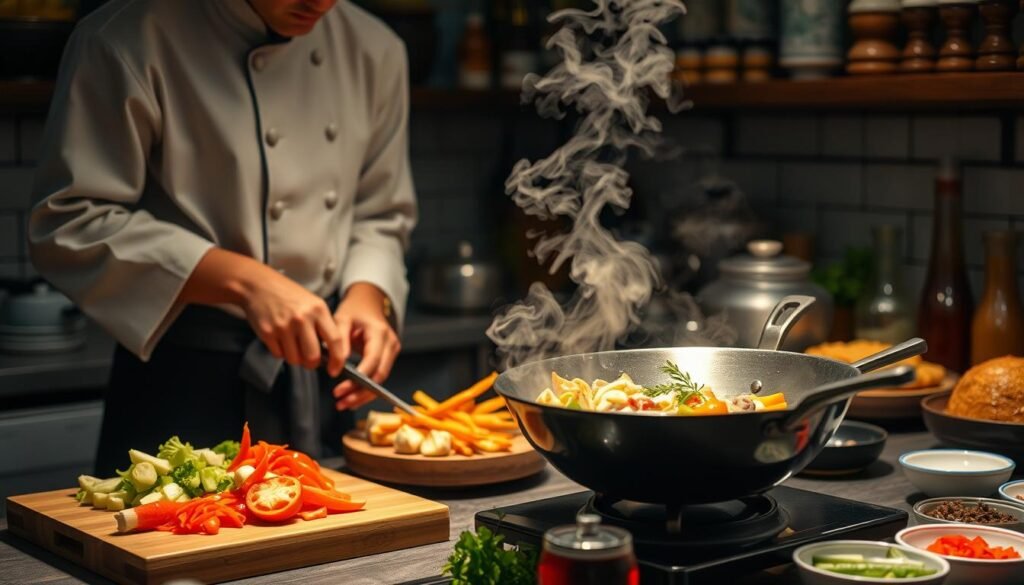
Pairing Korean Side Dishes with Main Dishes
Have you ever tried matching Korean side dishes with your top main dishes? This could make your meal unforgettable, especially if you love grilled meats or spicy food. Now, let’s find out which side dishes work best.
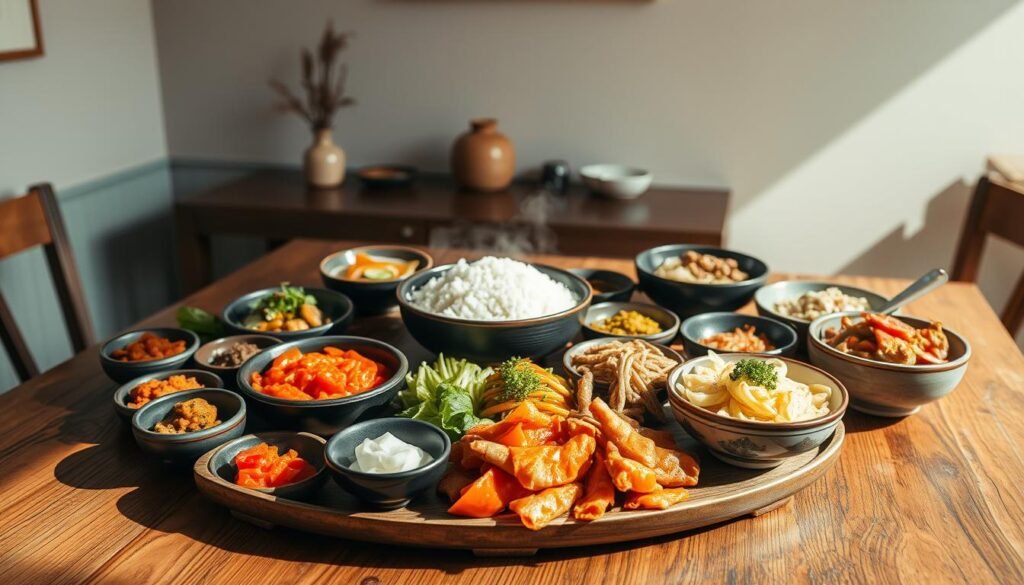
Best Side Dishes for BBQ Meats
Korean BBQ is known for its savory, juicy meats. Adding the right side dishes makes it even better. With BBQ meats like galbi or samgyeopsal, sides such as kimchi and pickled radishes are great. They mix well by offering different textures and tastes.
Complementing Spicy Dishes
Love spicy food? Choosing the right sides can be like an art. When eating something like kimchi jjigae or tteokbokki, sides like kongnamul muchim or gyeran jjim are perfect. They soften the spiciness, making every bite enjoyable.
Popular Korean Side Dishes to Try
Exploring Korean cuisine is an adventure of flavors and unique dishes! I’ll show you some favorite Korean sides that people around the world love. Let’s get ready to taste the amazing Japchae, Galbitang, and Oi Muchim!
Japchae: Savory Glass Noodles
Japchae is a beloved Korean dish. It has chewy glass noodles made from sweet potato starch. They’re stir-fried with colorful veggies and often beef. The mix of soy sauce, sesame oil, and sugar gives it a savory sweet taste. It’s perfect for celebrations but also great any day.
Galbitang: Short Rib Soup
Galbitang is a cozy soup that’s perfect for cold days. This beef short rib soup has a clear, flavorful broth. It’s seasoned with garlic, ginger, and green onions. The taste of beef stands out. It’s loved in the cold months and adds warmth to any meal.
Oi Muchim: Spicy Cucumber Salad
Oi Muchim is great if you like a little spice. This spicy cucumber salad has cucumbers with Korean chili flakes, garlic, vinegar, and sesame seeds. It’s full of flavor and goes well with grilled meats or as a snack. It’s a simple yet popular dish for its bold taste.
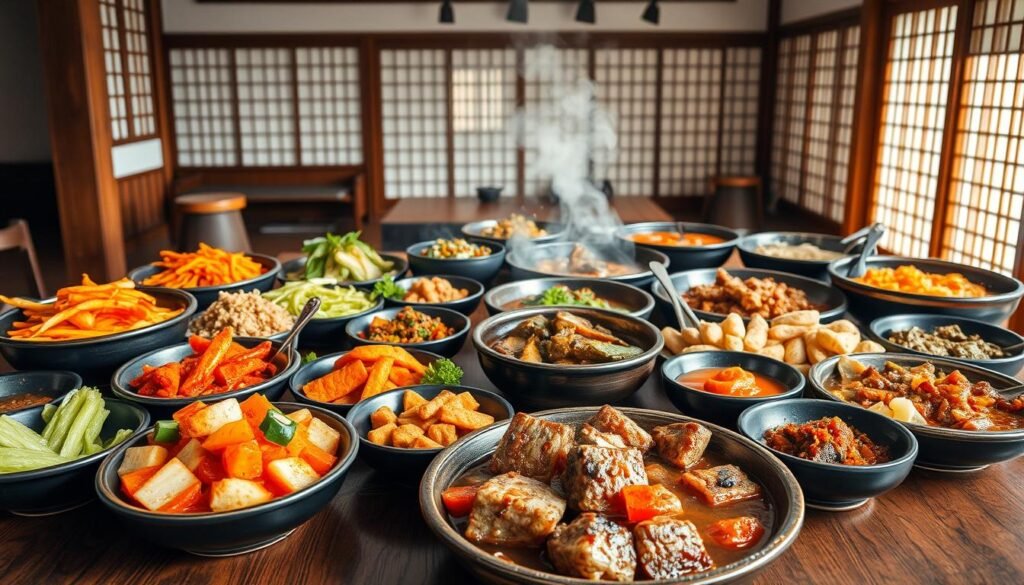
| Dish | Main Ingredients | Occasions |
|---|---|---|
| Japchae | Glass noodles, vegetables, beef | Festive events, everyday meals |
| Galbitang | Beef short ribs, garlic, ginger | Year-round, especially in colder months |
| Oi Muchim | Cucumbers, gochugaru, garlic, vinegar | Everyday meals, BBQs |
Storing and Reheating Korean Side Dishes
We all love leftover Korean side dishes. But how do we keep them fresh and delicious? Here are some great kitchen tips for storing and reheating Korean food to perfection!
Best Practices for Freshness
To store Korean food, make sure it’s airtight. Use clean, BPA-free containers or mason jars. For fermented stuff like kimchi, keep it in the fridge. This stops it from getting too sour.
Quick tip: Write down when you stored your food. Most Korean sides last about a week if stored right. Eat salads within a few days for the best taste.
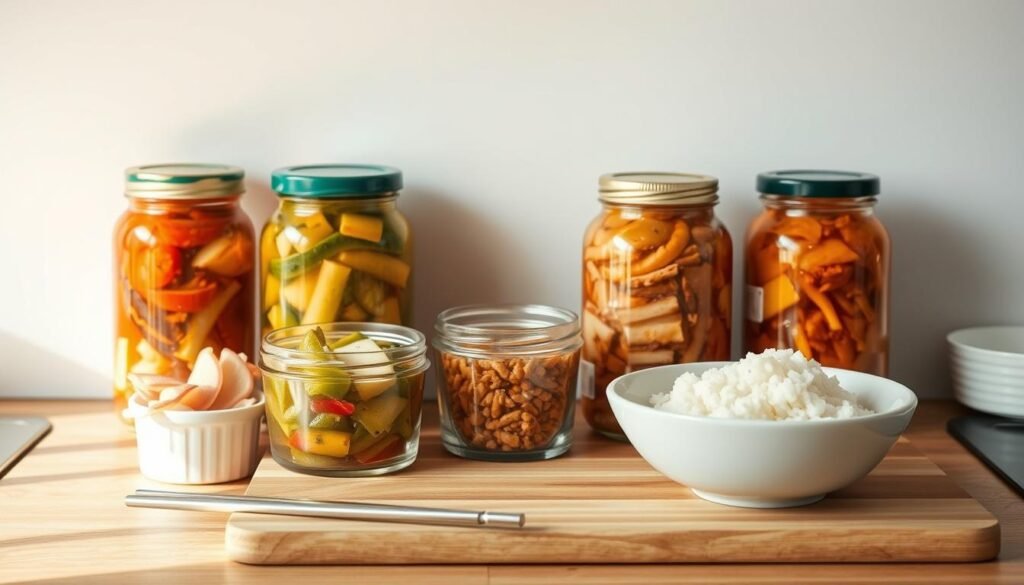
Tips for Reheating Without Losing Flavor
Reheating Korean dishes can be tricky. These tips will help keep their yummy taste. For japchae or stir-fried veggies, use a non-stick pan over medium heat. A little water or sesame oil can make it fresh again.
To reheat soups and stews, go slow in a saucepan on low heat. Stir now and then to heat it evenly. You can also use the microwave. Just cover the dish with something microwave-safe to keep it moist.
| Dish | Optimal Storage Method | Reheating Technique |
|---|---|---|
| Kimchi | Airtight container in the fridge | Eat cold or bring to room temperature |
| Japchae | Airtight container in the fridge | Reheat in a non-stick pan with a splash of water |
| Soup/Stew | Airtight container in the fridge | Reheat slowly in a saucepan on low heat |
Follow these kitchen tips for Korean food. You’ll always have fresh and tasty side dishes. Happy cooking!
Conclusion: Enjoying Korean Food Side Dishes
Korean side dishes offer a journey full of bright flavors and various textures. They make every meal better by adding culture. Banchan, or side dishes, add depth to both casual and fancy meals.
Embracing Variety in Every Meal
You’ll find many tastes in a Korean meal. The tangy Kimchi and savory Doenjang are examples. Try different side dishes with main courses for a full experience.
Korean food is great for its mix of flavors and balance. It’s all about enjoying different tastes together.
Sharing with Friends and Family
Sharing Korean food helps bring people closer. Eating together is key in Korean culture. It makes everyone feel part of something special.
Adding various side dishes to your meals does more than make them tasty. It also helps you connect with loved ones. Let Korean side dishes make your meals more enjoyable and shared.